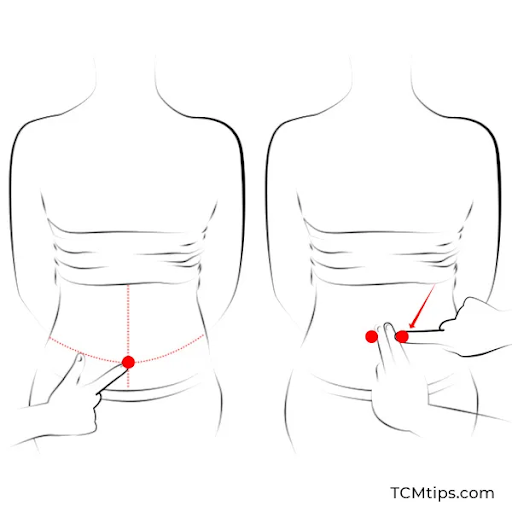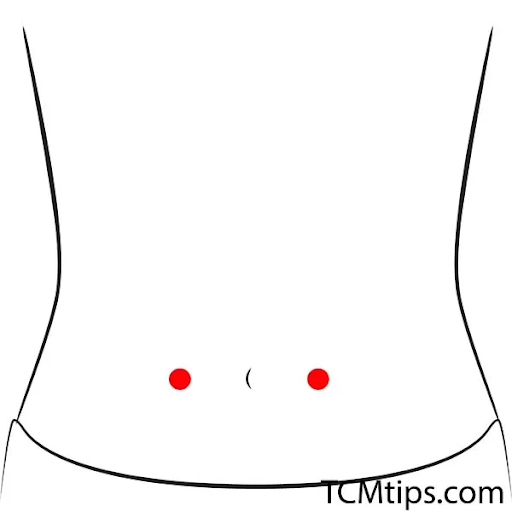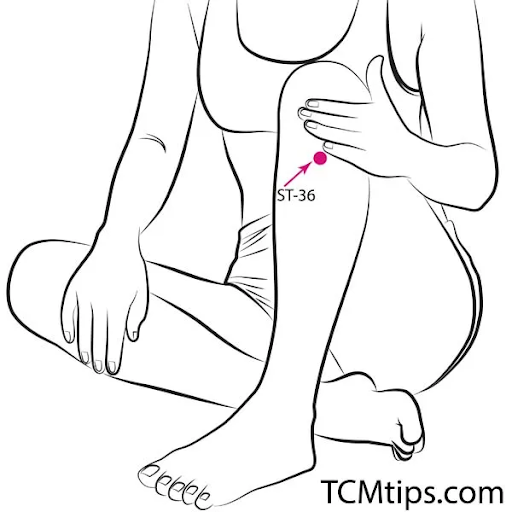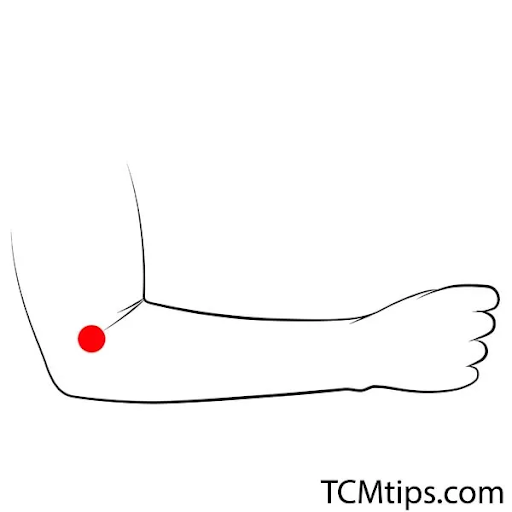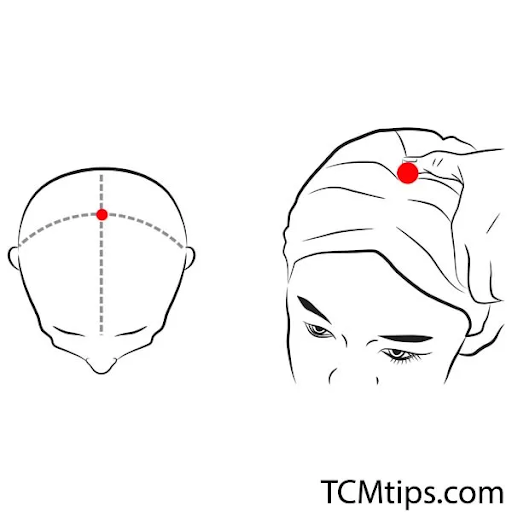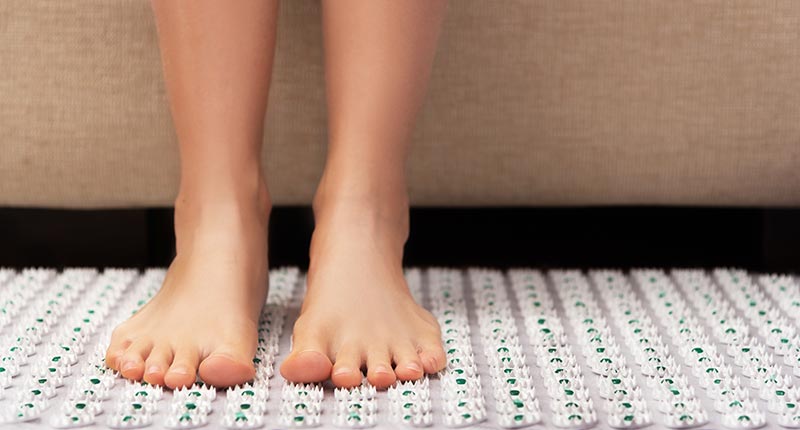Acupoint: LU-6 (Other Names: Lung-6/Kong Zui/Maximum Opening)
To learn about acupressure for bowel inflammation, you’ll first need to know about the acupuncture points to treat bowel inflammation.
To start with, the acupoint LU-6 is known as “Kongzui,” which means “Maximum Opening.” LU-6 is situated on the radial palmar aspect of the forearm, on the line joining LU 5 and LU 9, 7 cun above the transverse crease of the wrist. The LU-6 acupoint is classified as the Xi-Cleft point of the Lung Meridian.

The functions of acupoint LU-6 include descending and regulating Lung Qi, stopping bleeding, and to clear heat. The LU-6 is one of the most versatile acupuncture points to treat bowel inflammation, as well as:
– Bleeding hemorrhoids
– Chronic pain in the forearm
– Acute hemoptysis (coughing up blood)
– Sore throat, epistaxis (nosebleed)
– Cough and asthma
– Febrile diseases without sweating
A 2013 study found evidence of a lung-bowel connection (named the Gut-Lung axis) in people with Inflammatory Bowel Disease (IBD).
IBD is an ‘umbrella term’ for conditions involving chronic diseases of the gastrointestinal tract such as Crohn’s and Ulcerative Colitis, and is characterized by severe diarrhea, stomach pain, exhaustion, and weight loss.
They discovered that inflammation in the bowels of people with IBD is reflected by inflammation in the airways to the lungs and that inflammation is worse when IBD is active than when it is in remission.
Acupoint LU-6 is also used as acupressure points for arthritis in fingers and to relieve the related pain.
STAcupoint: Bl-25 (Other Names: Urinary Bladder-25/Da Chang/Large Intestine Transporter)
The acupoint Bl-25 is known as “Da Chang”. Bl-25 is situated on the back, 1.5 cun lateral to the lower border of the spinous process of the 4th lumbar vertebra. The Bl-25 acupoint is classified as the Back-Shu point of the large intestine.
Regulation of the large intestines, strengthening of the low back, and removal of obstructions from the meridian are some of the functions of Bl-25.
It is also used in conditions such as constipation, abdominal distention, diarrhea, bleeding hemorrhoids, urticaria, and lumbar pain and commonly to provide acupressure for bowel inflammation.
According to the findings of a 2016 animal study, electroacupuncture stimulation at Bl-25 can considerably reduce symptoms in rats with Irritable Bowel Syndrome.
Furthermore, studies conducted in 2007 and 2022 show that herbal acupuncture with Moxi-tar at Bl-25 is a viable preventative and/or therapeutic technique targeting chronic Inflammatory Bowel Disease in mice and that electroacupuncture at Bl-25 is useful in lowering visceral discomfort in an IBD mouse model.
Acupoint Bl-25 is also one of the acupressure points for back pain due to gas.
Acupoint: ST-25 (Other Names: Stomach-25/Tian Shu/Celestial Pivot)
The acupoint ST-25 is known as “Tianshu” which means “Celestial Pivot.” ST-25 is situated in the middle of the abdomen, 2 cun lateral to the umbilicus. ST-25 is classified as the Front-Mu point of the Large Intestine Meridian. This acupoint regulates Qi, Blood Spleen, Stomach, and intestines, and dispels Dampness and Damp-Heat.
ST-25 is one of the acupuncture points to treat bowel inflammation and has traditionally been used to treat:
– diarrhea and loose stool
– constipation
– undigested food,
– edema
– dysuria
– intestinal ulcers
– stomach pain
– abdominal discomfort
– menstrual irregularities.
A study concluded that electroacupuncture (EA) at ST-25 has a considerable analgesic impact on visceral discomfort in a rat model of post-inflammatory irritable bowel syndrome (PI-IBS).
Warming moxibustion (WM) is a traditional therapy based on Traditional Chinese Medicine theories. Its effects are mediated mostly through the heat of burning moxa, which is used to stimulate acupoints.
A 2017 study showed that warming moxibustion at ST-25 Tianshu is a potential treatment for diarrhea-dominant irritable bowel syndrome (D-IBS). These studies and evidence deduce that acupoint ST-25 undoubtedly is one of the most potential acupressure points for lower abdominal pain as well.
Acupoint: ST-36 (Other Names: Stomach-36/Zu San Li/Leg Three Miles)
The acupoint ST-36 is known as “Zusanli” which means “Leg Three Miles.” ST-36 is situated on the anterior aspect of the lower leg, 3 cun below ST 35, one finger-breadth (middle finger) from the anterior crest of the tibia.
ST-36 is classified as the He-Sea point of the Stomach Meridian. ST-36 harmonizes and strengthens the Spleen and Stomach, tones Qi and Blood, fortifies the body and Wei qi, elevates Yang, soothes the Shen, stimulates the meridian, and relieves pain and it is used vitally in acupressure for bowel inflammation.
Acupuncture can also help individuals with chronic functional dyspepsia to improve their mental and emotional state as well as their quality of life. ST-36 is one of the acupoints used to treat FD. ST-36 is a vital acupoint not just for ailments of the lower limbs, but also for the entire digestive system, with an effect on immunity.
According to one study, electroacupuncture at ST-36 had a therapeutic impact on rats with Ulcerative Colitis. ST-36 is also one of the potential acupressure points for peripheral neuropathy.
Acupoint: LI-11 (Other Names: Large Intestine-11/Qu Chi/Pool at the Crook)
The acupoint LI-11 is known as “Quchi” which means “Pool at the Crook.” LI-11 is situated on the lateral end of the transverse cubital crease, at the midpoint between LU 5 and the lateral epicondyle of the humerus.
Acupoint LI-11 is classified as the He-Sea Point of the Large Intestine Meridian. LI-11 Helps to clear heat, cools blood, removes dampness, expels outside wind, maintains Qi and Blood, stimulates meridian, and soothes itching.
This acupoint is used for the treatment of Sore throat, toothache, redness and irritation in the eyes, abscesses, rashes, upper extremity motor impairment, abdominal discomfort, vomiting, diarrhea, and febrile illnesses.
In clinical practice, electroacupuncture (EA) stimulation of acupressure point LI-11 (Quchi) has traditionally been used to treat constipation. LI-11 has traditionally been used to alleviate abdominal pain, vomiting, diarrhea, and acute gastroenteritis, making it an excellent choice for acupressure for bowel inflammation.
According to a 2015 study, EA at LI-11 had a favorable effect on objective markers of constipation, resulting in increased defecation frequency in a rat model. LI-11 is also one of the pressure points on the forearm to treat elbow pain, stiff shoulders, and numbness in the hands.
Acupoint: GV-20 (Other Names: The Governing Vessel-20/Bai Hui/Hundred Convergence)
The acupoint GV-20 is known as “Baihui” which means “Hundred Convergences.” GV-20 is situated 7 cun just above the posterior hairline, about on the midpoint of the line connecting the apexes of the two auricles.
GV-20 is a potent point of acupressure for bowel inflammation and it also reduces stress, lifts the spirits, tones yang, strengthens the Spleen’s ascending function, cleanses inner wind, and promotes resuscitation. Headache, dizziness, tinnitus, nasal blockage, apoplexy-induced aphasia, coma, mental problems, rectum, and uterine prolapse can be treated by this acupoint.
Since 2017, a randomized control trial has been underway to explore the efficacy and safety of acupuncture therapy for patients with Irritable Bowel Syndrome, with acupoint GV-20 being one of the points used in this investigation. GV-20 also serves as one of the acupressure points for anger.
 P. Sze
P. Sze 

